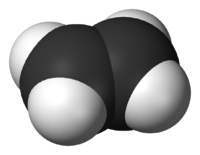
Photo from wikipedia
In this investigation, the terminal double bonds of the side chain epoxidized cardanol glycidyl ether (SCECGE) molecule were further epoxidized in the presence of Oxone® (potassium peroxomonosulfate) and fluorinated acetone.… Click to show full abstract
In this investigation, the terminal double bonds of the side chain epoxidized cardanol glycidyl ether (SCECGE) molecule were further epoxidized in the presence of Oxone® (potassium peroxomonosulfate) and fluorinated acetone. Regular methods for the double bond epoxidation are not effective on the terminal double bonds because of their reduced electronegativity with respect to internal double bonds. The terminal double bond functionality of the SCECGE was epoxidized to nearly 70%, increasing the epoxy functionality of SCECGE from 2.45 to 2.65 epoxies/molecule as measured using proton magnetic nuclear resonance (1H-NMR). This modified material—side chain epoxidized cardanol glycidyl ether with terminal epoxies (TE-SCECGE)—was thermally cured with cycloaliphatic curing agent 4-4′-methylenebis(cyclohexanamine) (PACM) at stoichiometry, and the cured polymer properties, such as glass transition temperature (Tg) and tensile modulus, were compared with SCECGE resin cured with PACM. The Tg of the material was increased from 52 to 69 °C as obtained via a dynamic mechanical analysis (DMA) while the tensile modulus of the material increased from 0.88 to 1.24 GPa as a result of terminal double bond epoxidation. In addition to highlighting the effects of dangling side groups in an epoxy network, this modest increase in Tg and modulus could be sufficient to significantly expand the potential uses of amine-cured cardanol-based epoxies for fiber reinforced composite applications.
Journal Title: Polymers
Year Published: 2020
Link to full text (if available)
Share on Social Media: Sign Up to like & get
recommendations!